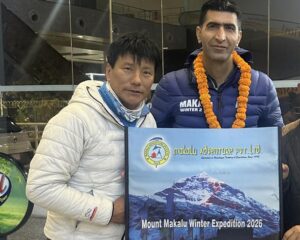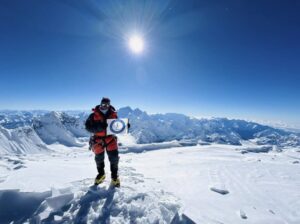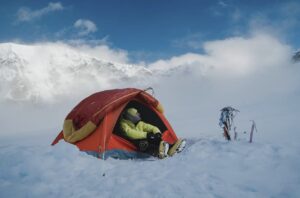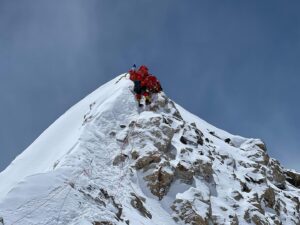They didn’t use down suits because lighter, layered clothing let them move faster. At 9 pm on May 9, Ecuadorians Karl Egloff and Nico Miranda set off from Makalu’s Advanced Base Camp and touched the summit 17m and 18 minutes later.
“It’s the hardest thing we’ve ever done, but also the most profound, emotional experience of our lives,” Karl Egloff wrote on social media today. Most surprisingly, this was their first 8,000m experience. They also used no supplementary O2.
Wind erased old tracks
Everything went well until Camp 3, Miranda wrote. “But then the wind increased and covered the tracks of those who had climbed before us, forcing us to break trail again.”

Nico (Nicolas) Miranda on the summit. Photo: Instagram
“From Camp 4, it got even worse, with stronger winds and clouds,” said Miranda. “We even considered whether to continue or to turn back. But we went on, passed 8,200m, and then…the sun rose on us, the wind stopped, and we saw the summit. Motivation grew and although from BC, they told us we were a bit late, we were too focused on the goal.”
Miranda says that their emotions at the top were indescribable. The descent “was a different story,” he said. They were already completely exhausted, and going down was the worst part of the climb.
Faster than Batard, but different route
The climbers confirmed that their time from ABC to the summit broke the previous record set by Marc Batard almost 35 years ago. The French climber, who is currently on Everest, took 18 hours to summit Makalu from ABC, according to Egloff. Batard actually began his push at BC, not ABC, and took a total of 19 hours 45 minutes to the summit.
Speed records on Himalayan peaks are always troublesome because conditions, ropes, and trail, the presence of other climbers, etc. vary each time. Batard climbed via the West Pillar, for example, rather than the current normal route. He also went without supplementary oxygen and completed the first traverse of the mountain.
Sky-running tactics
In an interview with Desnivel, the pair shared some technical details. They applied sky-running tactics to an 8,000’er. They explained that it is essential to make good time before reaching 8,000m. From that altitude forward, the runners are at their limits, and the pace slows to 100 vertical metres an hour or less.
Even at lower altitudes, some technical or crowded sections forced them to slow down. Thus, it was also important to know where to gain time. While the runners didn’t use down suits, which would have been too hot for their pace, they carried three litres of water each, two pairs of gloves, hats, glasses, and other basic gear.

A triumphant Karl Egloff at 8,463m. Photo: Karl Egloff
“The only aspect we didn’t consider was the indescribable exhaustion we felt on the way down,” Egloff said. “It was hard to move, we had to sit down from time to time and eat, gasping for air, and sometimes we vomited. I wish I had brought some specific food to keep our stomachs settled…Altitude-based exhaustion is incredibly hard.”
Nevertheless, Egloff and Miranda made it back down in 8 hours 30 minutes. Their total time recorded from/to Advanced Base Camp was 25 hours 48 minutes.
The climbers will take careful note of the lessons learned. Next year, they intend to repeat the feat on Mount Everest.






